cooling Lexus IS350 2021 / LEXUS 2021 IS 300, IS 350 (OM53E98U) User Guide
[x] Cancel search | Manufacturer: LEXUS, Model Year: 2021, Model line: IS350, Model: Lexus IS350 2021Pages: 436, PDF Size: 13.46 MB
Page 300 of 436
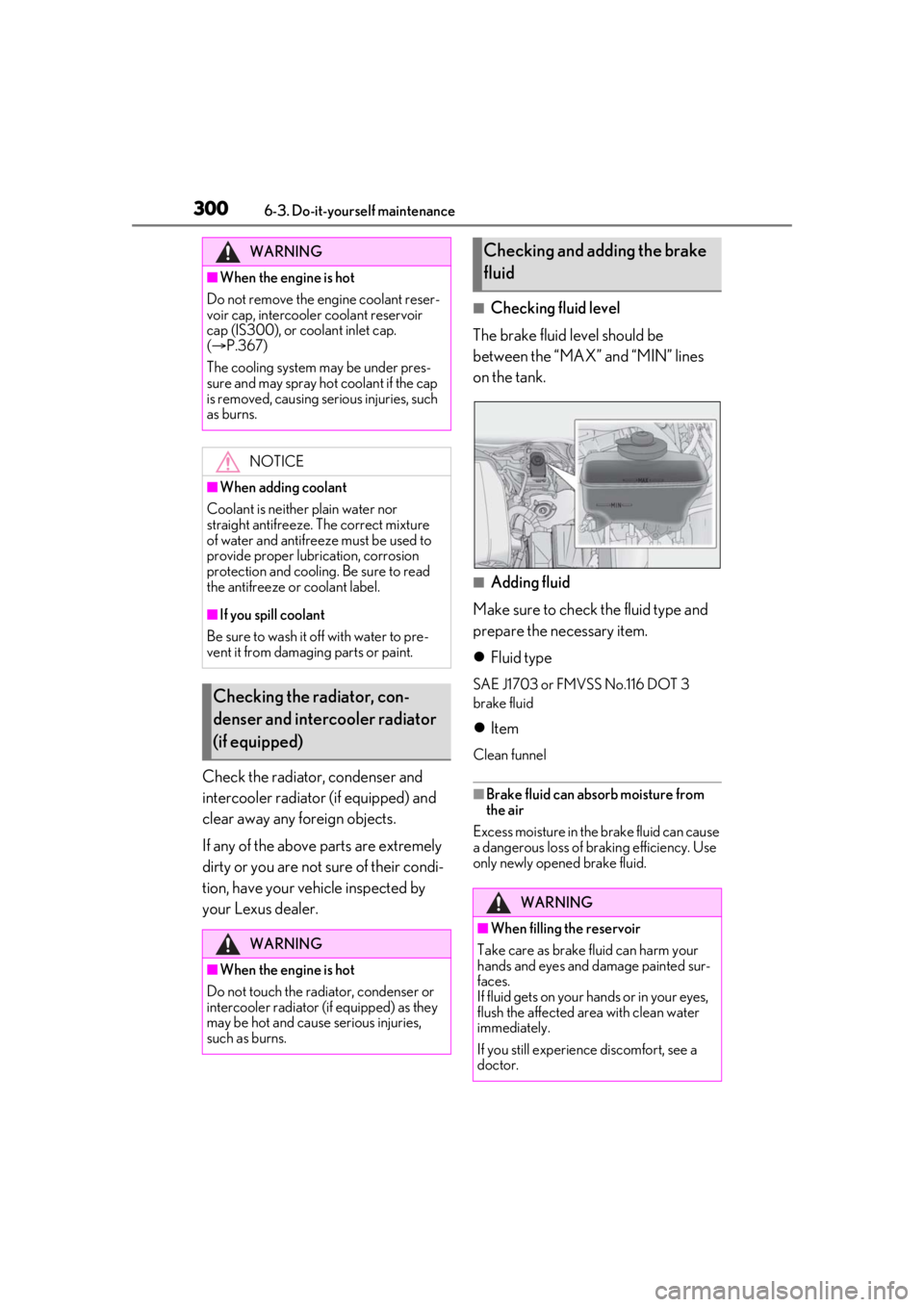
3006-3. Do-it-yourself maintenance
Check the radiator, condenser and
intercooler radiator (if equipped) and
clear away any foreign objects.
If any of the above parts are extremely
dirty or you are not sure of their condi-
tion, have your vehicle inspected by
your Lexus dealer.
■Checking fluid level
The brake fluid level should be
between the “MAX” and “MIN” lines
on the tank.
■Adding fluid
Make sure to check the fluid type and
prepare the necessary item.
Fluid type
SAE J1703 or FMVSS No.116 DOT 3
brake fluid
Item
Clean funnel
■Brake fluid can absorb moisture from
the air
Excess moisture in the brake fluid can cause
a dangerous loss of braking efficiency. Use
only newly opened brake fluid.
WARNING
■When the engine is hot
Do not remove the engine coolant reser-
voir cap, intercooler coolant reservoir
cap (IS300), or coolant inlet cap.
( P.367)
The cooling system may be under pres-
sure and may spray hot coolant if the cap
is removed, causing serious injuries, such
as burns.
NOTICE
■When adding coolant
Coolant is neither plain water nor
straight antifreeze. The correct mixture
of water and antifreeze must be used to
provide proper lubrication, corrosion
protection and cooling. Be sure to read
the antifreeze or coolant label.
■If you spill coolant
Be sure to wash it off with water to pre-
vent it from damagi ng parts or paint.
Checking the radiator, con-
denser and intercooler radiator
(if equipped)
WARNING
■When the engine is hot
Do not touch the radiator, condenser or
intercooler radiator (if equipped) as they
may be hot and cause serious injuries,
such as burns.
Checking and adding the brake
fluid
WARNING
■When filling the reservoir
Take care as brake fluid can harm your
hands and eyes and damage painted sur-
faces.
If fluid gets on your hands or in your eyes,
flush the affected area with clean water
immediately.
If you still experience discomfort, see a
doctor.
Page 364 of 436
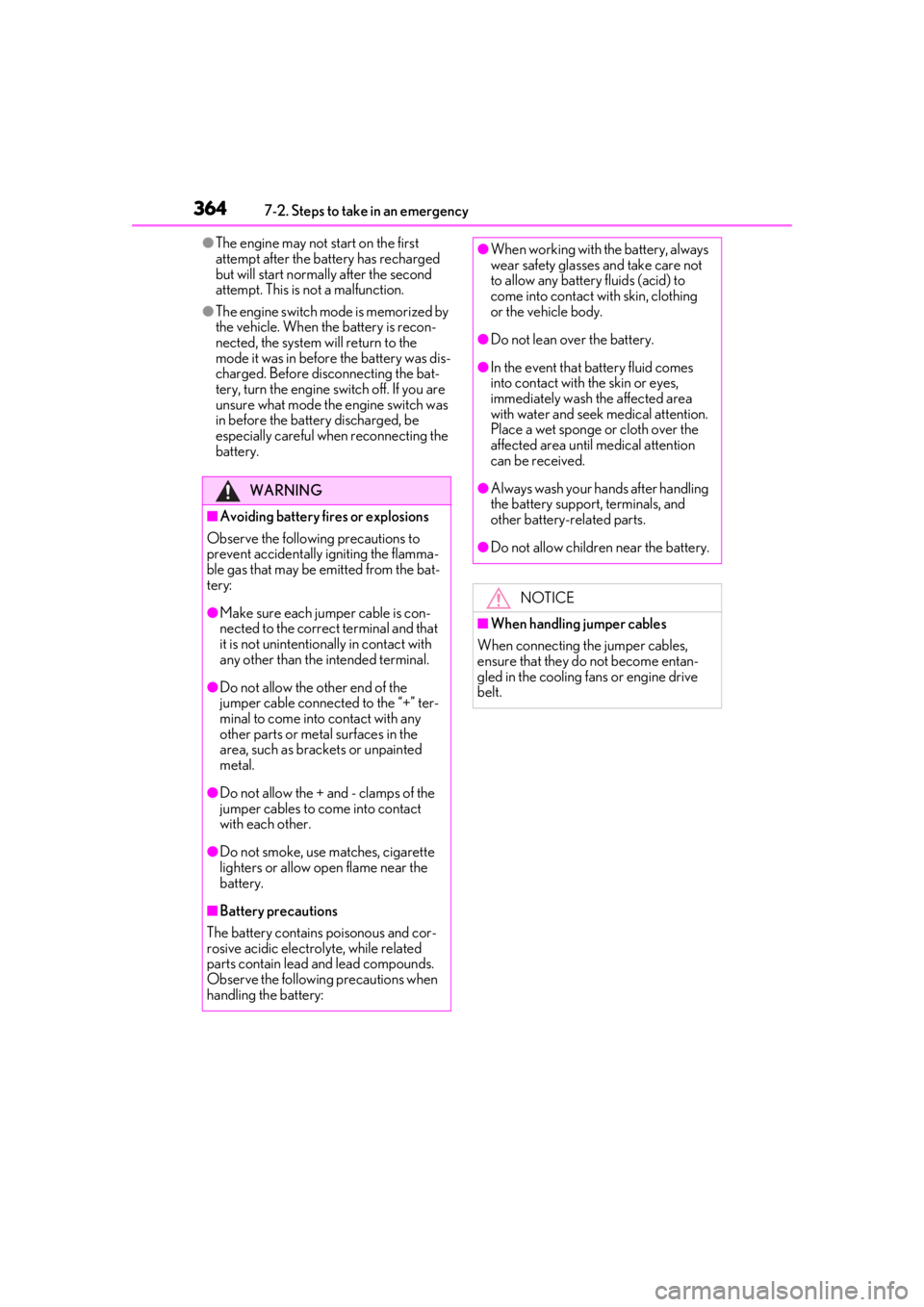
3647-2. Steps to take in an emergency
●The engine may not start on the first
attempt after the battery has recharged
but will start normally after the second
attempt. This is not a malfunction.
●The engine switch mode is memorized by
the vehicle. When the battery is recon-
nected, the system will return to the
mode it was in before the battery was dis-
charged. Before di sconnecting the bat-
tery, turn the engine switch off. If you are
unsure what mode the engine switch was
in before the battery discharged, be
especially careful when reconnecting the
battery.
WARNING
■Avoiding battery fires or explosions
Observe the following precautions to
prevent accidentally igniting the flamma-
ble gas that may be emitted from the bat-
tery:
●Make sure each jumper cable is con-
nected to the correct terminal and that
it is not unintentiona lly in contact with
any other than the intended terminal.
●Do not allow the other end of the
jumper cable connected to the “+” ter-
minal to come into contact with any
other parts or metal surfaces in the
area, such as brackets or unpainted
metal.
●Do not allow the + and - clamps of the
jumper cables to come into contact
with each other.
●Do not smoke, use matches, cigarette
lighters or allow open flame near the
battery.
■Battery precautions
The battery contains poisonous and cor-
rosive acidic electrolyte, while related
parts contain lead and lead compounds.
Observe the following precautions when
handling the battery:
●When working with the battery, always
wear safety glasses and take care not
to allow any battery fluids (acid) to
come into contact with skin, clothing
or the vehicle body.
●Do not lean over the battery.
●In the event that battery fluid comes
into contact with the skin or eyes,
immediately wash the affected area
with water and seek medical attention.
Place a wet sponge or cloth over the
affected area until medical attention
can be received.
●Always wash your ha nds after handling
the battery support, terminals, and
other battery-related parts.
●Do not allow children near the battery.
NOTICE
■When handling jumper cables
When connecting the jumper cables,
ensure that they do not become entan-
gled in the cooling fans or engine drive
belt.
Page 365 of 436
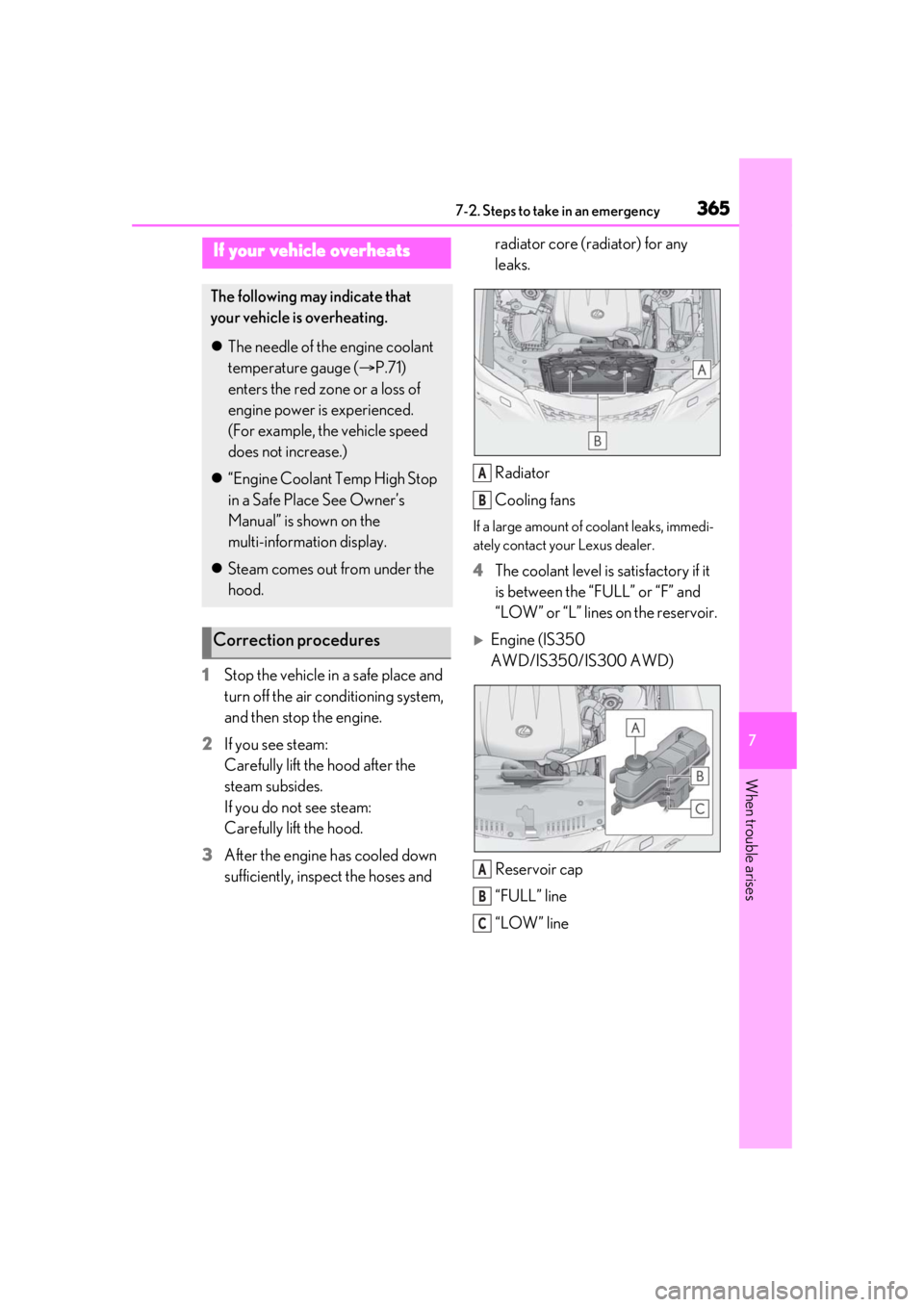
3657-2. Steps to take in an emergency
7
When trouble arises
1Stop the vehicle in a safe place and
turn off the air conditioning system,
and then stop the engine.
2 If you see steam:
Carefully lift the hood after the
steam subsides.
If you do not see steam:
Carefully lift the hood.
3 After the engine has cooled down
sufficiently, inspect the hoses and radiator core (radiator) for any
leaks.
Radiator
Cooling fans
If a large amount of coolant leaks, immedi-
ately contact your Lexus dealer.
4
The coolant level is satisfactory if it
is between the “FULL” or “F” and
“LOW” or “L” lines on the reservoir.
Engine (IS350
AWD/IS350/IS300 AWD)
Reservoir cap
“FULL” line
“LOW” line
If your vehicle overheats
The following may indicate that
your vehicle is overheating.
The needle of the engine coolant
temperature gauge ( P.71)
enters the red zone or a loss of
engine power is experienced.
(For example, the vehicle speed
does not increase.)
“Engine Coolant Temp High Stop
in a Safe Place See Owner’s
Manual” is shown on the
multi-information display.
Steam comes out from under the
hood.
Correction procedures
A
B
A
B
C
Page 366 of 436
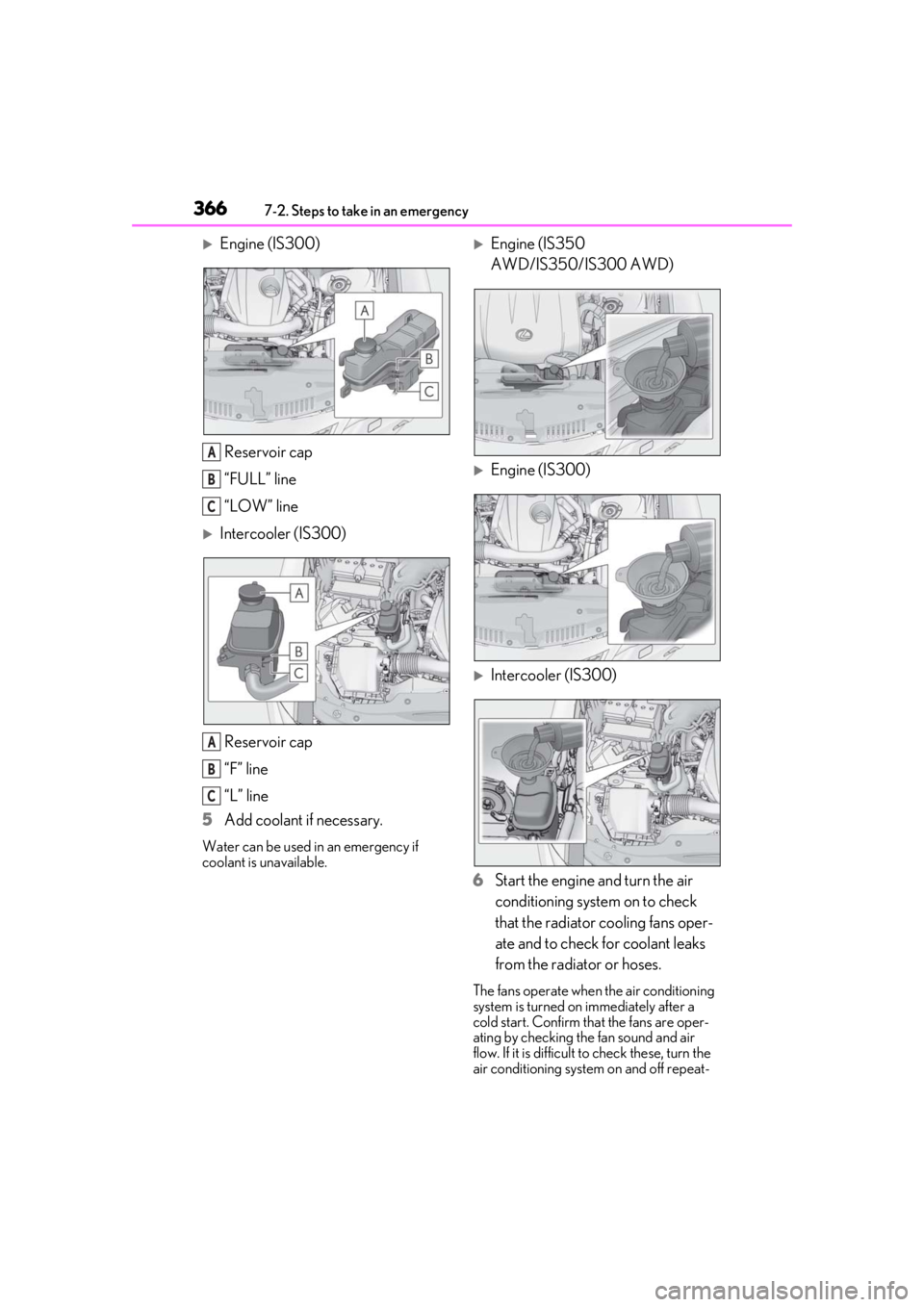
3667-2. Steps to take in an emergency
Engine (IS300)Reservoir cap
“FULL” line
“LOW” line
Intercooler (IS300)
Reservoir cap
“F” line
“L” line
5 Add coolant if necessary.
Water can be used in an emergency if
coolant is unavailable.
Engine (IS350
AWD/IS350/IS300 AWD)
Engine (IS300)
Intercooler (IS300)
6 Start the engine and turn the air
conditioning system on to check
that the radiator cooling fans oper-
ate and to check for coolant leaks
from the radiator or hoses.
The fans operate when the air conditioning
system is turned on immediately after a
cold start. Confirm that the fans are oper-
ating by checking the fan sound and air
flow. If it is difficult to check these, turn the
air conditioning system on and off repeat-
A
B
C
A
B
C
Page 368 of 436
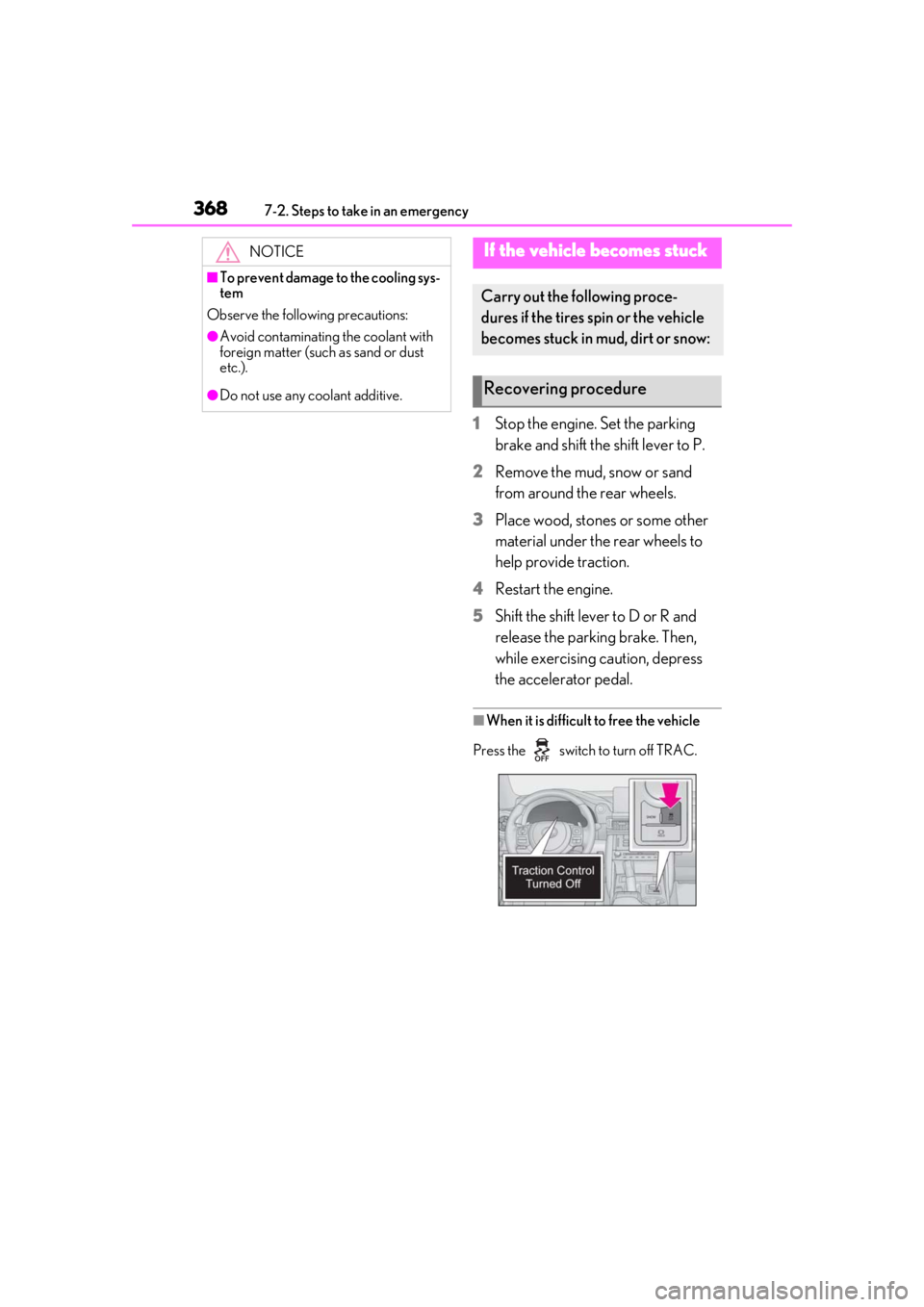
3687-2. Steps to take in an emergency
1Stop the engine. Set the parking
brake and shift the shift lever to P.
2 Remove the mud, snow or sand
from around the rear wheels.
3 Place wood, stones or some other
material under the rear wheels to
help provide traction.
4 Restart the engine.
5 Shift the shift lever to D or R and
release the parking brake. Then,
while exercising caution, depress
the accelerator pedal.
■When it is difficult to free the vehicle
Press the switch to turn off TRAC.
NOTICE
■To prevent damage to the cooling sys-
tem
Observe the following precautions:
●Avoid contaminating the coolant with
foreign matter (such as sand or dust
etc.).
●Do not use any coolant additive.
If the vehicle becomes stuck
Carry out the following proce-
dures if the tires spin or the vehicle
becomes stuck in mud, dirt or snow:
Recovering procedure
Page 376 of 436
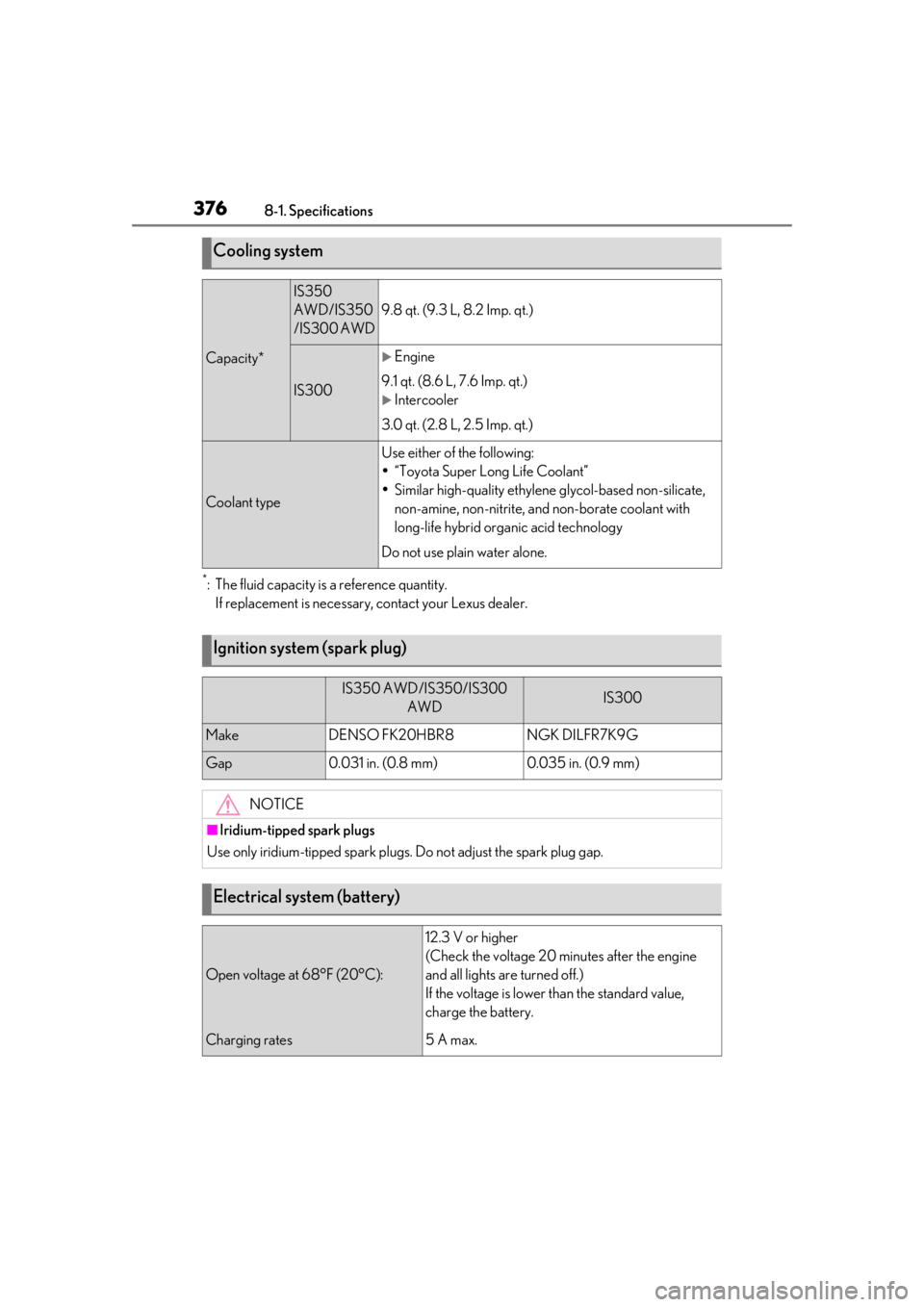
3768-1. Specifications
*: The fluid capacity is a reference quantity.If replacement is necessary, contact your Lexus dealer.
Cooling system
Capacity*
IS350
AWD/IS350
/IS300 AWD
9.8 qt. (9.3 L, 8.2 Imp. qt.)
IS300
Engine
9.1 qt. (8.6 L, 7.6 Imp. qt.)
Intercooler
3.0 qt. (2.8 L, 2.5 Imp. qt.)
Coolant type
Use either of the following:
“Toyota Super Long Life Coolant”
Similar high-quality ethylene glycol-based non-silicate,
non-amine, non-nitrite, and non-borate coolant with
long-life hybrid orga nic acid technology
Do not use plain water alone.
Ignition system (spark plug)
IS350 AWD/IS350/IS300 AWDIS300
MakeDENSO FK20HBR8NGK DILFR7K9G
Gap0.031 in. (0.8 mm)0.035 in. (0.9 mm)
NOTICE
■Iridium-tipped spark plugs
Use only iridium-tipped spark plugs. Do not adjust the spark plug gap.
Electrical system (battery)
Open voltage at 68°F (20°C):
12.3 V or higher
(Check the voltage 20 minutes after the engine
and all lights are turned off.)
If the voltage is lower than the standard value,
charge the battery.
Charging rates5 A max.
Page 422 of 436
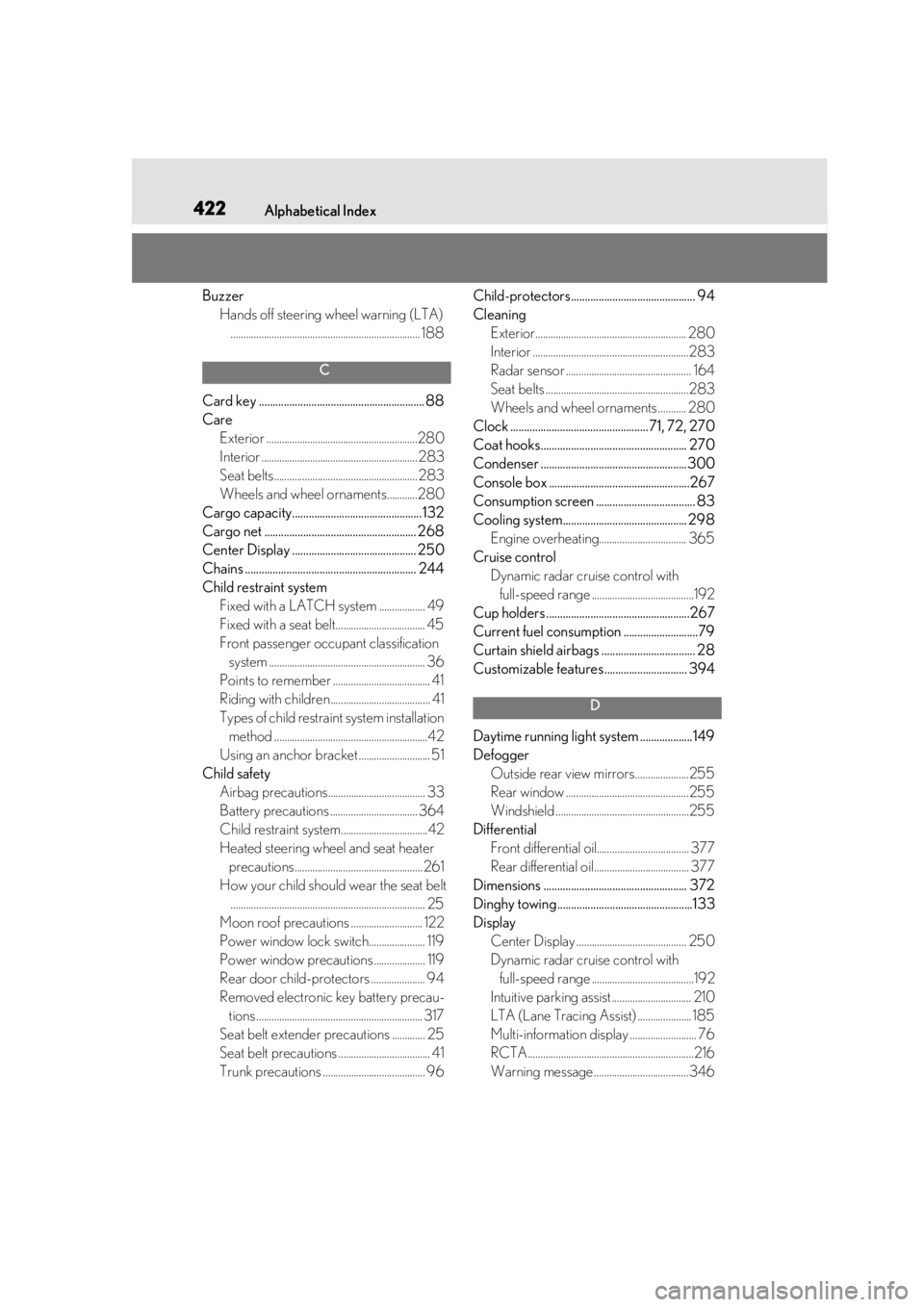
422Alphabetical Index
BuzzerHands off steering wheel warning (LTA).......................................................................... 188
C
Card key ............................................................ 88
Care Exterior ...........................................................280
Interior ............................................................. 283
Seat belts........................................................ 283
Wheels and wheel ornaments............280
Cargo capacity...............................................132
Cargo net ....................................................... 268
Center Display ............................................. 250
Chains .............................................................. 244
Child restraint system Fixed with a LATCH system .................. 49
Fixed with a seat belt................................... 45
Front passenger occupant classification system ............................................................. 36
Points to remember ...................................... 41
Riding with children ....................................... 41
Types of child restraint system installation method ............................................................42
Using an anchor bracket ............................ 51
Child safety Airbag precautions...................................... 33
Battery precautions .................................. 364
Child restraint system..................................42
Heated steering wheel and seat heater precautions.................................................. 261
How your child should wear the seat belt ............................................................................ 25
Moon roof precautions ............................ 122
Power window lock switch...................... 119
Power window precautions .................... 119
Rear door child-protectors ..................... 94
Removed electronic key battery precau- tions ................................................................. 317
Seat belt extender precautions ............. 25
Seat belt precautions .................................... 41
Trunk precautions ........................................ 96 Child-protectors............................................. 94
Cleaning
Exterior........................................................... 280
Interior .............................................................283
Radar sensor ................................................. 164
Seat belts ........................................................283
Wheels and wheel ornaments ........... 280
Clock ..................................................71, 72, 270
Coat hooks..................................................... 270
Condenser .....................................................300
Console box ...................................................267
Consumption screen .................................... 83
Cooling system............................................. 298 Engine overheating.................................. 365
Cruise control Dynamic radar cruise control with full-speed range ........................................192
Cup holders ....................................................267
Current fuel consumption ...........................79
Curtain shield airbags .................................. 28
Customizable features .............................. 394
D
Daytime running light system ...................149
Defogger Outside rear view mirrors.....................255
Rear window ................................................255
Windshield ....................................................255
Differential Front differential oil............. ....................... 377
Rear differential oil......... ..................... ....... 377
Dimensions .................................................... 372
Dinghy towing.................................................133
Display Center Display ........................................... 250
Dynamic radar cruise control with full-speed range ........................................192
Intuitive parking assist ............................... 210
LTA (Lane Tracing Assist) ..................... 185
Multi-information display .......................... 76
RCTA.................................................................216
Warning message .....................................346